Uncovering Nature's Ingenuity: Lessons from Our Native Gardens This Spring
"Nature does not hurry, yet everything is accomplished." – Lao Tzu
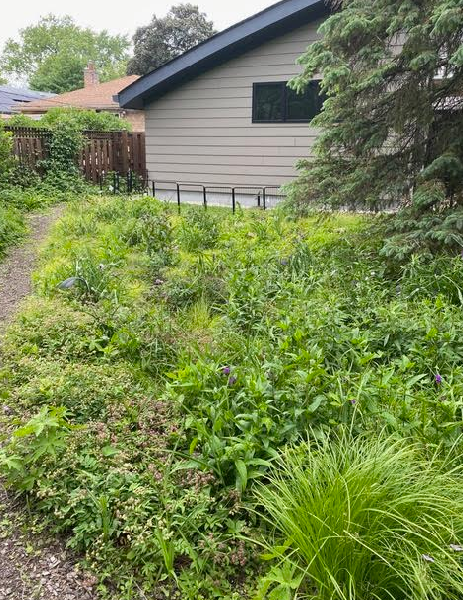 7-Year-Old Rain Garden
7-Year-Old Rain GardenThe Dynamics of a Rain Garden
 Take rain gardens, for instance. These aren't just pretty features; they’re hardworking ecological systems. These specially designed depressions collect stormwater runoff, allowing it to slowly soak into the ground instead of overwhelming storm drains. And guess what? Native plants are the superstars of these systems! We were particularly excited watching Virginia Waterleaf (Hydrophyllum virginianum) in a newly installed rain garden. This fantastic native groundcover is already spreading its rich green carpet, doing exactly what it’s meant to: covering bare soil and managing moisture. It is also an early food source to many pollinators and a host plant to the native Waterleaf Mining Bee! Check out our Eco(fun)Fact below to learn more about the power of Virigina Waterleaf. Photo to the left courtesy of illinioswildflower.info.
Take rain gardens, for instance. These aren't just pretty features; they’re hardworking ecological systems. These specially designed depressions collect stormwater runoff, allowing it to slowly soak into the ground instead of overwhelming storm drains. And guess what? Native plants are the superstars of these systems! We were particularly excited watching Virginia Waterleaf (Hydrophyllum virginianum) in a newly installed rain garden. This fantastic native groundcover is already spreading its rich green carpet, doing exactly what it’s meant to: covering bare soil and managing moisture. It is also an early food source to many pollinators and a host plant to the native Waterleaf Mining Bee! Check out our Eco(fun)Fact below to learn more about the power of Virigina Waterleaf. Photo to the left courtesy of illinioswildflower.info.In another client’s rain garden with a distinct downward slope, we witnessed the Hydrophyllum’s remarkable resilience. It wasn't deterred by the incline; instead, it literally went "down the slope to find a new home!" This is a prime example of a plant actively seeking equilibrium, leveraging its natural growth habit to spread and stabilize the environment. It truly highlights how nature inherently seeks balance by getting the ground covered.
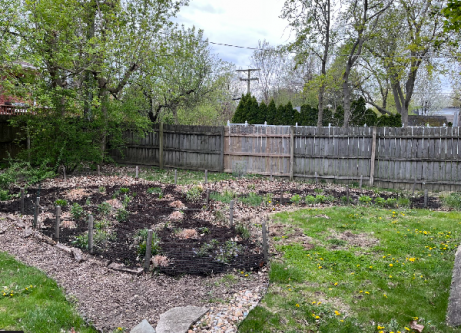 Photo: Rain garden with a downward slope. The Hydrophyllum went down the slope to find a new home.
Photo: Rain garden with a downward slope. The Hydrophyllum went down the slope to find a new home.Unpacking Plant Personalities
During a recent, very enjoyable spring stewardship session with a client, we spent time observing individual plant behaviors. Our Big Leaf Aster (Eurybia macrophylla) was "pupping out" with enthusiasm, sending out new shoots from its root system. This fascinating behavior illustrates how these plants naturally propagate and expand, filling out garden spaces with their vigorous, healthy growth. T
T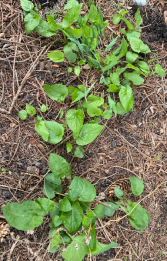 hen there’s the ongoing saga of Creeping Bellflower (Campanula rapunculoides).This plant, with its delicate purple flowers, often presents a conundrum. It sings a "siren song" of beauty, but it's an aggressive spreader. The question often becomes: "To control or not to control?" Our general advice for native gardens is to politely but firmly keep it out to ensure the health & diversity of your desired native plant community. It’s a good lesson in understanding which plants truly serve the ecological goals of your garden.
hen there’s the ongoing saga of Creeping Bellflower (Campanula rapunculoides).This plant, with its delicate purple flowers, often presents a conundrum. It sings a "siren song" of beauty, but it's an aggressive spreader. The question often becomes: "To control or not to control?" Our general advice for native gardens is to politely but firmly keep it out to ensure the health & diversity of your desired native plant community. It’s a good lesson in understanding which plants truly serve the ecological goals of your garden.Pictures: We really enjoyed spring stewardship with a client and discovered Creeping Bellflower (Campanula rapunculoides).
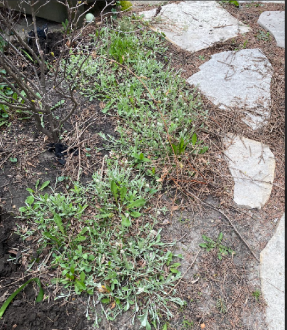
 Even humble plants like Pussy Toes (Antennaria plantaginifolia) (left) play a crucial role in our local ecosystem. These tiny, charming plants form dense, weed-suppressing mats, illustrating nature's inherent drive to keep the soil covered and healthy. What's even more exciting is that Pussy Toes are a host plant for the American Painted Lady butterfly(Vanessa cardui). This beautiful butterfly also relies on its botanical cousin, Pearly Everlasting(Anaphalis margaritacea), which is also in the Asteraceae family. In fact, during a recent spring install, we added Pearly Everlasting to a client's garden, and the very next day, they had an American Painted Lady visiting the plant! It's true: plant them, and they will come! These connections highlight how every native plant choice contributes to a vibrant, living garden.
Even humble plants like Pussy Toes (Antennaria plantaginifolia) (left) play a crucial role in our local ecosystem. These tiny, charming plants form dense, weed-suppressing mats, illustrating nature's inherent drive to keep the soil covered and healthy. What's even more exciting is that Pussy Toes are a host plant for the American Painted Lady butterfly(Vanessa cardui). This beautiful butterfly also relies on its botanical cousin, Pearly Everlasting(Anaphalis margaritacea), which is also in the Asteraceae family. In fact, during a recent spring install, we added Pearly Everlasting to a client's garden, and the very next day, they had an American Painted Lady visiting the plant! It's true: plant them, and they will come! These connections highlight how every native plant choice contributes to a vibrant, living garden.Embrace the Ease, Enjoy the Beauty
This summer, consider how much easier and more rewarding gardening can be when you allow native plants to take the lead. They are designed for this landscape, resilient, and incredibly beneficial. We love helping Chicagoland homeowners discover the joy of a low-maintenance, high-impact native garden. Ready to let your garden work smarter, not harder?______________________________________________________________________________________________________________________________
Eco(Fun)Fact: The Worker Plant: Virginia Waterleaf
Did you know that some of the most charming plants in our local ecosystems are also incredibly hardworking? Take Virginia Waterleaf (Hydrophyllum virginianum), for instance. This delightful woodland ephemeral, native to our region, is one of spring's earliest bloomers, offering a crucial nectar source for native bees, flies, and other early emerging pollinators when few other options are available. Notably, it's a host plant for the specialized Waterleaf Mining Bee (Andrena geranii), which relies on it for its larval food, making it an essential part of the life cycle for this beneficial native bee. Its unique leaves, often appearing to have "watermarks" or silvery blotches, add visual interest to the understory, creating a beautiful groundcover effect before other plants fully leaf out.Beyond its early season beauty and vital role as a spring "pantry" for insects, Virginia Waterleaf is an excellent choice for shady, naturalized areas in your garden. It excels as a natural water manager, helping to absorb and slow down stormwater runoff, contributing to healthier local waterways and soils. It also helps suppress weeds and stabilize soil, contributing to healthy soil structure. As the summer progresses, its foliage often recedes, making way for later-season plants. This natural lifecycle contributes to a dynamic and resilient native garden, demonstrating how even seemingly small plants play a significant role in supporting the intricate web of life right in our own backyards.
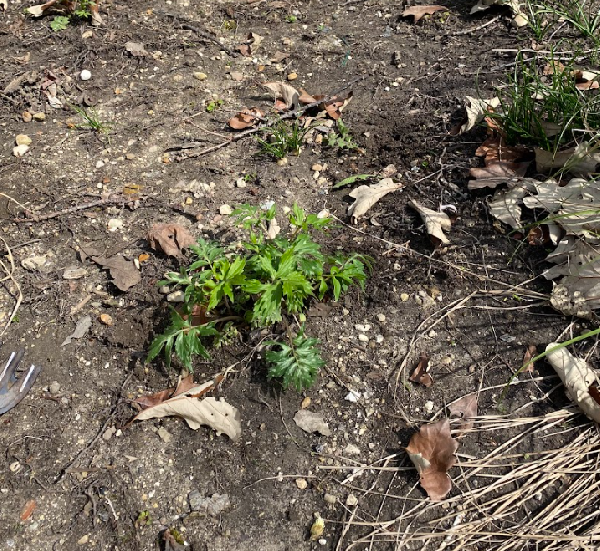 Virginia Waterleaf (Hydrophyllum virginianum) spreading its ground cover magic for a clients rain garden
Virginia Waterleaf (Hydrophyllum virginianum) spreading its ground cover magic for a clients rain garden Virigina Waterleaf growing seedheads
Virigina Waterleaf growing seedheads
Virigina Waterleaf unique leaves with "water marks" - Photo courtesy of illinoiswildflower.info
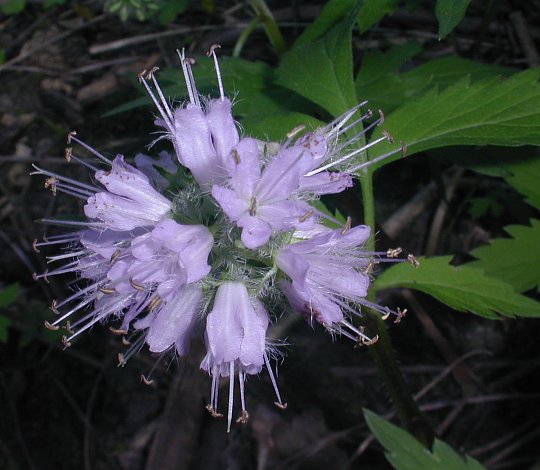
Virigina Waterleaf in full bloom - Photo courtesy of illinoiswildflower.info
 Female Waterleaf Mining Bee - Photo courtesy of Vermont Atlas of Life
Female Waterleaf Mining Bee - Photo courtesy of Vermont Atlas of Life



